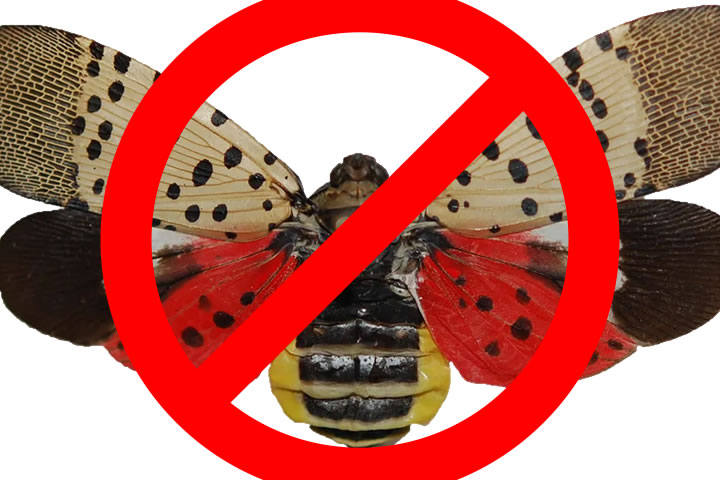A favorite maxim of the 21st century is that the world is getting smaller. This is usually a nod to our growing interconnectivity across the world. The condensing of the planet is manifest in other, less promising ways. Pestilences once confined to one hemisphere are finding their ways across the oceans, leaving devastation in their wake. A most recent example is the invasion of the eastern United States by the Spotted Lanternfly (SLF), indigenous to southern and East Asia. Known as a planthopper, this insect is not content to feast on crops. Its presence can cause widespread economic damage, aided and abetted by trucks.
The Spotted What??
Scientifically called Lycorma delicatula, the Spotted Lanternfly originates primarily in China, India, and Vietnam. Biologically related to cicadas and aphids, Lanternflies are about an inch long and a half-inch in width. Their wings are white, black, and red while their undersides are yellow and black. Before they reach maturity, they are black with white spots. One notable aspect of their appearance is when they are resting — they assume a greyish shade allowing them a cloak of camouflage.
These insects typically lay one set of eggs annually, the mass of which may sometimes be mistaken for gypsy moth eggs. Although their wings are striking, the Lanternflies transport themselves by jumping, with wings as an aid to their sturdy legs. On the one hand, they congregate in large, dense crowds; to lay eggs, however, they are known to disperse far from their center, putting them in the fall to hatch in the spring. Their tastes are wide and varied when it comes to feeding. Among the 70 plant species that attract Lanternflies are:
- Grapes
- Hops
- Nuts
- Apples
- Peaches
- Hardwood trees
South Korea has seen massive damage to its vineyards and grape industry because of these pests. With suction organs projected from the mouth, they remove the fluids that sustain life in fruit and woody plants. Their proliferation is a dangerous occurrence for agriculture and nature preservation.
Other Consequences of Spotted Lanternfly (SLF) Populations
While drawing out the sap from plant tissue, the SLF also excretes a substance called honeydew. Not only does honeydew entice bees, wasps, and flies, it also rots and yields a “sooty mold.” This residue further damages vegetation by obstructing the vital elements of sunlight required for photosynthesis. Because the U.S. lacks the predators that feed on SLFs in their native habitat–certain wasp species, for example–the exponential propagation of these pests calls for intervention and management by humans, both governments and individuals.
Understanding the Spread
Unfortunately, humans unwittingly bear some responsibility in the territorial conquest already enjoyed by SLFs in the eastern states. Given the insect’s propensity to lay eggs on smooth surfaces, like those on trailers pulled by trucks, and that the eggs appear almost like mud to the naked eye, it is no surprise that they are transported to far-flung locations via interstate highways and byways.
Controlling and Preventing SLF Populations
Quarantines
Governments of the affected states have identified the boundaries of infestation and are imposing quarantines to contain any expansion. Virginia, for example, imposed quarantines on one city and one county where significant SLF presence is confirmed. Under these restrictions, those doing business in the area must procure a permit from the state Department of Agriculture and Consumer Services (VDACS); inspect those vehicles and materials that are identified as hosts for SLF eggs, and present a certified statement to the effect that an inspection was performed according to VDACS guidelines. At-risk materials include trucks, crates, lumber, firewood, grills, lawn mowers, patio furniture, and recreational vehicles. Quarantines represent a baseline action government can take to address the SLF proliferation issue. They do not eliminate the problem, however.
Pesticides
Although direct pesticide application against SLFs is a foolproof way of terminating the pests, it is not a practical way given their large numbers. Challenging farmers is the task of finding the right insecticide that can cover plants and neutralize the SLFs as an extra layer. Some of the products tested require humans to remain away from the fields for hours, or even days, at a time before re-entry is safe. Most non-contact pesticides kill the SLFs slowly by upsetting the nervous system or by disturbing their feeding cycles. A study conducted by the Pennsylvania State University Extension focused on 17 products that bested a 50 percent mortality rate.
Chemicals were tested on both peach trees and potted grape vines. Five of the pesticides ranked as superior in terms of efficacy. Not all of them were labeled as effective against SLFs and needed to register for label modification. Farmers will select their products based not only on SLF kill rates, but also on the side-effects relative to soil health, runoff content, crop quality and consequences for beneficial insects.
Natural Control Methods
The Organic Materials Review Institute approves those insecticides that meet its naturally-based guidelines. There are currently two such substances that have its certification. Only one, however, demonstrates any significant effect on SLF occupation. It has yet to be labeled as such.
The Batkoa fungus is showing great promise an SLF inhibitor. A Cornell University study contends that this organism has a hallucinogenic effect on SLFs, encouraging them to draw near. When they do, the fungus entraps the flies and constricts them in its fibers. Eventually, the SLFs burst, releasing spores that attract other flies to the fungus. Much research is still pending, but Batkoa is native to this continent and available.
What Can You Do?
Truckers and prospective drivers are vital in helping authorities break the menace of the Spotted Lanternfly. Identifying their host materials and discerning the presence of their eggs keeps this economic scourge from growing worse. A better economy for rural regions means more opportunities for trucking professionals.
Spotted Lanternfly in the news:
Expert warns Lanternfly tape poses danger to wildlife
Invasive spotted lanternflies are currently in nymph stage: here’s what they look like












